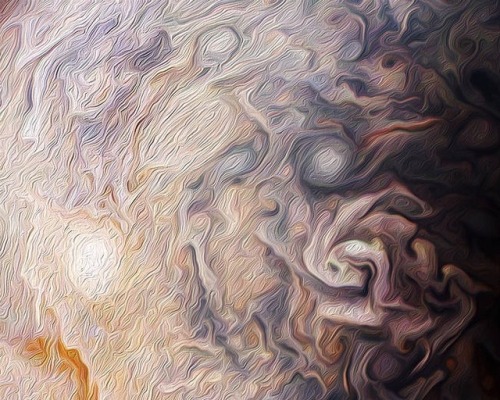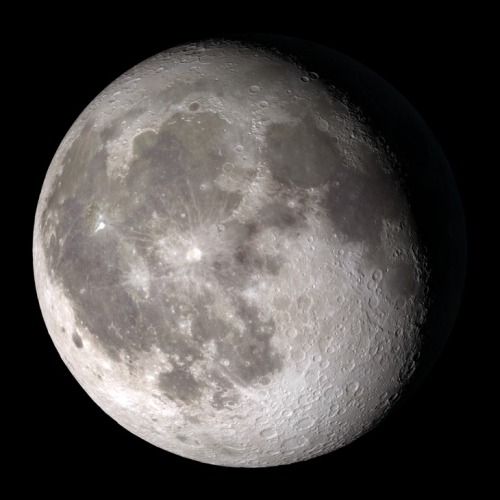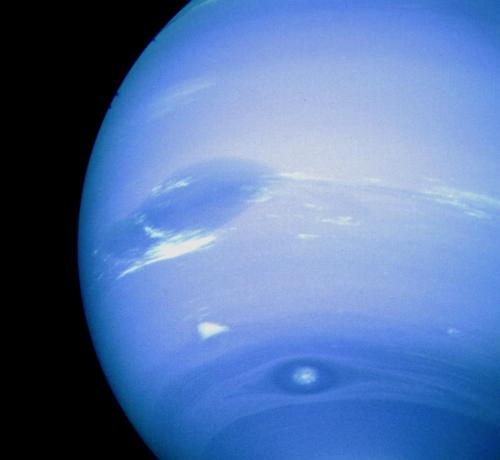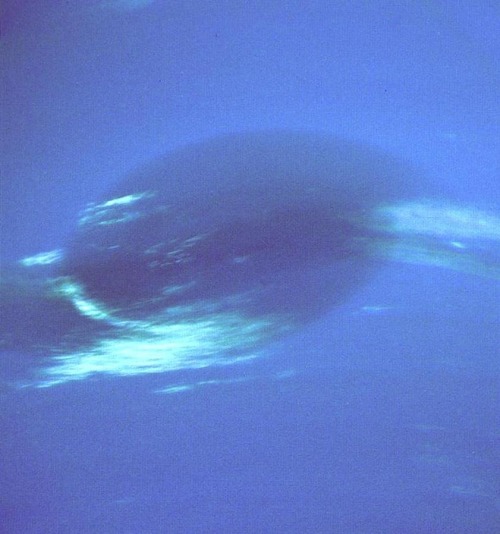Estudos!
Estudos!
Exercitando Física Matemática!!
More Posts from Carlosalberthreis and Others
O povo brasileiro está aguardando se o #BolsonaroVaiCair antes do mês de dezembro desse ano, pois será difícil que ainda seja presidente em 2022.


Citizen scientist Rick Lundh created this abstract Jovian artwork using data from the JunoCam imager on NASA’s Juno spacecraft.
Image credits: NASA/JPL-Caltech/SwRI/MSSS/Rick Lundh
6 Ways NASA Space Communications Connect Astronauts to Earth
1. When Astronauts Phone Home, the Space Network Answers

Operated by our Goddard Space Flight Center in Greenbelt, Maryland, this communications system enables all types of Earth-to-astronaut communication. The Space Network is a complex system of ground station terminals and satellites. The satellites, called ‘Tracking and Data Relay Satellites’ or TDRS, provide continuous communications for human spaceflight 24/7/365. The information this network relays includes astronaut communication with Mission Control in Houston, posting live video of spacewalks and live interviews with schools, even posting Tweets on Twitter and doing Facebook posts. The Space Network can even broadcast live 4K, ultra-HD video right from the station. You can now watch an astronaut eat a space taco in high definition. WHAT A TIME TO BE ALIVE!
2. The Space Network Also Communicates Science Data

Astronauts on the Space Station perform experiments on the station that will enable our Journey to Mars and other future human space missions. For example, astronaut Peggy Whitson works on a bone cell study that could lead to better preventative care or therapeutic treatments for people suffering bone loss as a result of bone diseases like osteopenia and osteoporosis, or for patients on prolonged bed rest. All that fantastic data is sent back to Earth via our Space Network for scientists around the world to analyze and build on.
3. The Space Network Transmits Spacecraft Health Data

The Space Network not only lets us communicate with the astronauts, it also tracks the ‘health’ of the spacecraft, be it the International Space Station where the astronauts are living, a cargo vehicle servicing the space station, or even, in the near future, crewed vehicles to other worlds. We deliver data on a spacecraft’s state of health, from power generation levels and avionics status to carbon dioxide and oxygen levels, and more to Mission Control 24/7/365.
4. The Space Network Helps Monitor Spacecraft Location

The International Space Station Is pretty big, but space is bigger. The Space Network enables flight controllers on the ground to provide a GPS-type service for the Space Station, letting them track the exact location of the space station at all times as it orbits the Earth. It also allows us Earth-bound folk to get real-time text updates when the Space Station is flying overhead. If you want to track the station, sign up here: https://spotthestation.nasa.gov
5. The Space Network Supports Launch Vehicles

Goddard’s Space Network also controls all the communications for all the missions that go to the space station. That includes command and telemetry services during launches, free flight, berthing and un-berthing to the station, as well as re-entry and landing back to Earth.
6. The Space Network Is Also Looking Toward the Future

It’s also helping to test vehicles that will carry astronauts to other worlds. Currently, they are working with teams for our Space Launch System and commercial crew vehicles. The first flights for these vehicles will occur in 2018 and 2019, setting us on the road to Journey to Mars! This image shows the Orion capsule that will aid in our continuous march into space.
What’s Next for the Space Network?
We’re continuing to grow! Watch out for the launch of a new TDRS spacecraft in August 2017! TDRS-M is coming. Check out more info here and join our countdown to TDRS launch: https://tdrs.gsfc.nasa.gov.
The Moon in Motion
Happy New Year! And happy supermoon! Tonight, the Moon will appear extra big and bright to welcome us into 2018 – about 6% bigger and 14% brighter than the average full Moon. And how do we know that? Well, each fall, our science visualizer Ernie Wright uses data from the Lunar Reconnaissance Orbiter (LRO) to render over a quarter of a million images of the Moon. He combines these images into an interactive visualization, Moon Phase and Libration, which depicts the Moon at every day and hour for the coming year.

Want to see what the Moon will look like on your birthday this year? Just put in the date, and even the hour (in Universal Time) you were born to see your birthday Moon.
Our Moon is quite dynamic. In addition to Moon phases, our Moon appears to get bigger and smaller throughout the year, and it wobbles! Or at least it looks that way to us on Earth. This wobbling is called libration, from the Latin for ‘balance scale’ (libra). Wright relies on LRO maps of the Moon and NASA orbit calculations to create the most accurate depiction of the 6 ways our Moon moves from our perspective.
1. Phases

The Moon phases we see on Earth are caused by the changing positions of the Earth and Moon relative to the Sun. The Sun always illuminates half of the Moon, but we see changing shapes as the Moon revolves around the Earth. Wright uses a software library called SPICE to calculate the position and orientation of the Moon and Earth at every moment of the year. With his visualization, you can input any day and time of the year and see what the Moon will look like!
2. Shape of the Moon

Check out that crater detail! The Moon is not a smooth sphere. It’s covered in mountains and valleys and thanks to LRO, we know the shape of the Moon better than any other celestial body in the universe. To get the most accurate depiction possible of where the sunlight falls on the lunar surface throughout the month, Wright uses the same graphics software used by Hollywood design studios, including Pixar, and a method called ‘raytracing’ to calculate the intricate patterns of light and shadow on the Moon’s surface, and he checks the accuracy of his renders against photographs of the Moon he takes through his own telescope.

3. Apparent Size

The Moon Phase and Libration visualization shows you the apparent size of the Moon. The Moon’s orbit is elliptical, instead of circular - so sometimes it is closer to the Earth and sometimes it is farther. You’ve probably heard the term “supermoon.” This describes a full Moon at or near perigee (the point when the Moon is closest to the Earth in its orbit). A supermoon can appear up to 14% bigger and brighter than a full Moon at apogee (the point when the Moon is farthest from the Earth in its orbit).
Our supermoon tonight is a full Moon very close to perigee, and will appear to be about 14% bigger than the July 27 full Moon, the smallest full Moon of 2018, occurring at apogee. Input those dates into the Moon Phase and Libration visualization to see this difference in apparent size!
4. East-West Libration
Over a month, the Moon appears to nod, twist, and roll. The east-west motion, called ‘libration in longitude’, is another effect of the Moon’s elliptical orbital path. As the Moon travels around the Earth, it goes faster or slower, depending on how close it is to the Earth. When the Moon gets close to the Earth, it speeds up thanks to an additional pull from Earth’s gravity. Then it slows down, when it’s farther from the Earth. While this speed in orbital motion changes, the rotational speed of the Moon stays constant.
This means that when the Moon moves faster around the Earth, the Moon itself doesn’t rotate quite enough to keep the same exact side facing us and we get to see a little more of the eastern side of the Moon. When the Moon moves more slowly around the Earth, its rotation gets a little ahead, and we see a bit more of its western side.
5. North-South Libration

The Moon also appears to nod, as if it were saying “yes,” a motion called ‘libration in latitude’. This is caused by the 5 degree tilt of the Moon’s orbit around the Earth. Sometimes the Moon is above the Earth’s northern hemisphere and sometimes it’s below the Earth’s southern hemisphere, and this lets us occasionally see slightly more of the northern or southern hemispheres of the Moon!
6. Axis Angle

Finally, the Moon appears to tilt back and forth like a metronome. The tilt of the Moon’s orbit contributes to this, but it’s mostly because of the 23.5 degree tilt of our own observing platform, the Earth. Imagine standing sideways on a ramp. Look left, and the ramp slopes up. Look right and the ramp slopes down.
Now look in front of you. The horizon will look higher on the right, lower on the left (try this by tilting your head left). But if you turn around, the horizon appears to tilt the opposite way (tilt your head to the right). The tilted platform of the Earth works the same way as we watch the Moon. Every two weeks we have to look in the opposite direction to see the Moon, and the ground beneath our feet is then tilted the opposite way as well.
So put this all together, and you get this:
Beautiful isn’t it? See if you can notice these phenomena when you observe the Moon. And keep coming back all year to check on the Moon’s changing appearance and help plan your observing sessions.
Follow @NASAMoon on Twitter to keep up with the latest lunar updates.
Make sure to follow us on Tumblr for your regular dose of space: http://nasa.tumblr.com.

How Well Do You Know Mercury?
Mercury is the smallest planet in our solar system and is only slightly larger than Earth’s moon. To give you some perspective, if the sun were as tall as a typical front door, Earth would be the size of a nickel and Mercury would be about as big as a green pea.

Mercury is the closest planet to the sun. Daytime temperatures can reach 430 degrees Celsius (800 degrees Fahrenheit) and drop to –180 degrees Celsius (-290 degrees Fahrenheit) at night.
Here are a few fun facts about Mercury:
Mercury takes only 88 Earth days to orbit the sun
If we could stand on Mercury’s surface when it is at its closest point to the sun, the sun would appear more than three times larger than it does here on Earth
Mercury is home to one of the largest impact basins in the solar system: the Caloris Basin. The diameter of this impact basin is the length of 16,404 football fields (minus the end zones) placed end to end!
Mercury is one of only two planets in our solar system that do not have moons (Venus is the other one)
Mercury completes three rotations for every two orbits around the sun. That means that if you wanted to stay up from sunrise to sunrise on Mercury, you’d be up for 176 Earth days…you’d need a LOT of coffee!

Two missions have visited Mercury:
Mariner 10 was the first mission to Mercury, and 30 years later, our MESSENGER mission was the second to visit the planet. Mariner 10 was also the first spacecraft to reach one planet by using the gravity of another planet (in this case, Venus) to alter its speed and trajectory.

MESSENGER was the first spacecraft to orbit Mercury, The spacecraft had its own shades to protect it from the light of the sun. This is important since sunlight on Mercury can be as much as 11 times brighter than it is here on Earth. The spacecraft was originally planned to orbit Mercury for one year, but exceeded expectations and worked for over four years capturing extensive data. On April 30, 2015, the spacecraft succumbed to the pull of solar gravity and impacted Mercury’s surface.
Water Ice?
The MESSENGER spacecraft observed compelling support for the long-held hypothesis that Mercury harbors abundant water ice and other frozen volatile materials in its permanently shadowed polar craters.

This radar image of Mercury’s north polar region. The areas shown in red were captured by MESSENGER, compared to the yellow deposits imaged by Earth-based radar. These areas are believed to consist of water ice.
Mercury Transit of the Sun
For more than seven hours on Monday, May 9, Mercury will be visible as a tiny black dot crossing the face of the sun. This rare event – which happens only slightly more than once a decade – is called a transit.

Where: Skywatchers in Western Europe, South America and eastern North America will be able to see the entirety of the transit. The entire 7.5-hour path across the sun will be visible across the Eastern U.S. – with magnification and proper solar filters – while those in the West can observe the transit in progress at sunrise.

Watch: We will stream a live program on NASA TV and the agency’s Facebook page from 10:30 to 11:30 a.m. – an informal roundtable during which experts representing planetary, heliophysics and astrophysics will discuss the science behind the Mercury transit. Viewers can ask questions via Facebook and Twitter using #AskNASA. Unlike the 2012 Venus transit of the sun, Mercury is too small to be visible without magnification from a telescope or high-powered binoculars. Both must have safe solar filters made of specially-coated glass or Mylar; you can never look directly at the sun.
To learn more about our solar system and the planets, visit: http://solarsystem.nasa.gov/
Make sure to follow us on Tumblr for your regular dose of space: http://nasa.tumblr.com

É hoje pessoal! 🤩
🔭 Logo mais às 4:30 da manhã vai ocorrer a "super" conjunção entre todos os planetas do sistema solar.
✨ Dos planetas visíveis a olho nu em ordem ascendente, são: Mercúrio, Vênus, Marte, Júpiter e Saturno.
✨ Dos planetas que não estão visíveis, mas que estão acompanhando, são: Urano e Netuno.
📷 Créditos da Imagem: https://m.facebook.com/story.php?story_fbid=pfbid09eF4zUQy47zDfGrguVwDEny8vut32ZphgyifThgejTEoujRK7G8iwNHoMQxh1LKbl&id=213098328862069

Dunas e cratera na porção oeste de Meroe Patera em Marte.
What’s Up for May 2016?

What’s Up for May? Two huge solar system highlights: Mercury transits the sun and Mars is closer to Earth than it has been in 11 years.

On May 9, wake up early on the west coast or step out for coffee on the east coast to see our smallest planet cross the face of the sun. The transit will also be visible from most of South America, western Africa and western Europe.

A transit occurs when one astronomical body appears to move across the face of another as seen from Earth or from a spacecraft. But be safe! You’ll need to view the sun and Mercury through a solar filter when looking through a telescope or when projecting the image of the solar disk onto a safe surface. Look a little south of the sun’s Equator. It will take about 7 ½ hours for the tiny planet’s disk to cross the sun completely. Since Mercury is so tiny it will appear as a very small round speck, whether it’s seen through a telescope or projected through a solar filter. The next Mercury transit will be Nov. 11, 2019.

Two other May highlights involve Mars. On May 22 Mars opposition occurs. That’s when Mars, Earth and the sun all line up, with Earth directly in the middle.

Eight days later on May 30, Mars and Earth are nearest to each other in their orbits around the sun. Mars is over half a million miles closer to Earth at closest approach than at opposition. But you won’t see much change in the diameter and brightness between these two dates. As Mars comes closer to Earth in its orbit, it appears larger and larger and brighter and brighter.

During this time Mars rises after the sun sets. The best time to see Mars at its brightest is when it is highest in the sky, around midnight in May and a little earlier in June.

Through a telescope you can make out some of the dark features on the planet, some of the lighter features and sometimes polar ice and dust storm-obscured areas showing very little detail.

After close approach, Earth sweeps past Mars quickly. So the planet appears large and bright for only a couple weeks.

But don’t worry if you miss 2016’s close approach. 2018’s will be even better, as Mars’ close approach will be, well, even closer.
You can find out about our #JourneytoMars missions at mars.nasa.gov, and you can learn about all of our missions at http://www.nasa.gov.
Make sure to follow us on Tumblr for your regular dose of space: http://nasa.tumblr.com


This photograph of Neptune was reconstructed from two images taken by Voyager 2’s narrow-angle camera, through the green and clear filters. At the north (top) is the Great Dark Spot, accompanied by bright, white clouds that undergo rapid changes in appearance.
Credit: NASA
